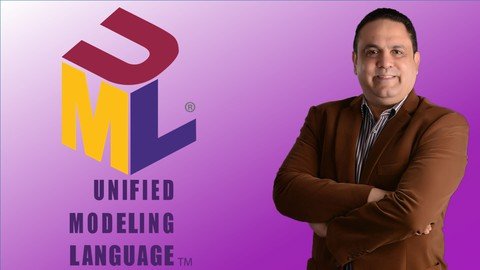
Last updated 1/2023
MP4 | Video: h264, 1280x720 | Audio: AAC, 44.1 KHz
Language: English | Size: 839.67 MB | Duration: 3h 45m
An online course to Learn how to read UML diagrams, interpret every UML notation and build them using practical examples
What you'll learn
Gain a working knowledge UML 2.0
Apply knowledge of OOAD to design an object-oriented system which can be implemented in an object-oriented language
Learn the meaning of every UML notation and when to use them
Learn the industry best practices to build UML
Interpret any UML diagram effectively
Increase your software development productivity
Requirements
Basic Object Oriented knowledge is preferable.
Description
Last updated: 14-Oct-2017 Added a new lecture "Guidelines for building quality Class Diagrams"
Currently The course contains The Use Case diagram, Use case description, activity diagram, class diagram, object diagram, package diagram, sequence diagram and state transition diagram. "Outstanding explanations and examples. Taught in an insightful and practical manner. The teacher is an obvious expert in the field."---Sean ODonnell"Nice and easy to follow. The instructor engages effectively and reinforces the topics."---Ishaq Aslam
Software practitioners have used modeling languages for decades to specify, visualize, construct, and document systems. UML which stands for The Unified Modeling Language (UML) is one of those languages and today UML is the most used standard modeling language for software and systems development. Even though not everyone need to write UML diagrams , Most software practitioners, if not all of them, need to interpret and read diagrams written by others.
UML is used to express software or system requirements, architecture, and design. After taking this course. UML will make it easy for you to communicate technical matters with other developers, analysts, designers, testers and even your clients. So it improve your ability to communicate with others and will also improve your team productivity as it will be easier to use UML to express complicated technical matters with others in much less time.
In this course, I talk about all the different UML diagrams Use cases, class diagrams, sequence diagrams, activity diagram and more. I will talk about each of them in detail. You will learn how to read and comprehend any UML diagram and you also learn the important guidelines to build them provided by subject matter experts. We will have workshops to read and build diagrams together. All these can be achieved with little effort just by watching this course.
In this course, we will learn by example, starting by quickly demonstrate some the notations of a diagram then explain in detail the variations of each of those notations. Then will introduce more notations and then discuss them and so on.
When done learning how to read any diagram, We will explain how to build diagrams using those notations and the guidelines that we should follow to use each notations.
Join this course now and I promise that you will be able to read any UML diagram and build neat , quality UML diagrams in no time
Overview
Section 1: Introduction to UML (Unified Modeling Language)
Lecture 1 Why UML?[CC]
Lecture 2 About Me[CC]
Lecture 3 Our Learning Methodology[CC]
Section 2: Use Case Diagram
Lecture 4 What is a Use Case?[CC]
Lecture 5 Importance of a Good Use Case[CC]
Lecture 6 Use Case Diagram : The Basics[CC]
Lecture 7 Stereotypes[CC]
Lecture 8 Advanced Use Case Notations[CC]
Lecture 9[Activity] : Can you read this Use Case diagram?[CC]
Lecture 10 Guidelines for Building a Quality Use Case Diagram[CC]
Section 3: Use Case Specification
Lecture 11 Use Case Specification: Elements[CC]
Lecture 12 Use Case Specification: Example[CC]
Lecture 13 Use Case Specification: Example Enhanced[CC]
Lecture 14 Use Case Specification: Another Template[CC]
Lecture 15 Guidelines for Building a Quality Use Case Specification[CC]
Section 4: Building Use case diagram and description Workshop
Lecture 16 Building Use case diagram and description Process[CC]
Lecture 17 Introducing our UML tool "UMLet"
Lecture 18 Another Case Study: The problem
Lecture 19 Another Case Study: The Draft Use Case Diagram
Lecture 20 Another Case Study: The Use Case Description
Lecture 21 Another Case Study: The Final Use Case Diagram
Section 5: Activity Diagrams
Lecture 22 Activity Diagrams: Introduction[CC]
Lecture 23 Activity Diagrams: The Basics[CC]
Lecture 24 Activity Diagrams: Advanced
Lecture 25 Guidelines for Building a Quality Activity Diagram[CC]
Lecture 26[Activity] : Can you read this Activity diagram?[CC}
Section 6: Class Diagrams
Lecture 27 Class Diagrams: Introduction[CC]
Lecture 28 Class Diagrams: The Beginning[CC]
Lecture 29 Class Diagrams: The Attributes[CC]
Lecture 30 Class Diagrams: The Operations[CC]
Lecture 31 Class Diagrams Relationships:Dependency,Association,Aggregation,Composition[CC]
Lecture 32 Class Diagrams Relationships: It is Complicated[CC]
Lecture 33 Class Diagram Guidelines : The Basics
Lecture 34 Class Diagram Guidelines : The relationships
Lecture 35[Activity] : Can you read this Class diagram?[CC}
Section 7: Object Diagrams
Lecture 36 The Object Diagram[CC]
Lecture 37[Activity]: Can you read this object diagram?[CC}
Section 8: Package Diagrams
Lecture 38 Package Diagrams: Introduction[CC]
Lecture 39 Package Diagrams: The Basics[CC]
Lecture 40 Package Diagrams: Advanced[CC]
Section 9: Sequence Diagrams
Lecture 41 Sequence Diagrams: Introduction[CC]
Lecture 42 Sequence Diagrams: The Basics[CC]
Lecture 43 Sequence Diagrams: Advanced[CC]
Lecture 44[Activity] Can you read these sequence diagram?
Section 10: State Transition Diagrams
Lecture 45 State Transition Diagrams: Introduction[CC]
Lecture 46 State Transition Diagrams: The Basics[CC]
Lecture 47 State Transition Diagrams: Advanced[CC]
Section 11: Deprecated Videosgnore
Lecture 48 Our Methodology[CC]
Lecture 49 Guidelines for Building a Quality Use Case Specification[CC]
Section 12: At the end
Lecture 50 Thank You[CC]
Lecture 51 Bonus Lecture
Software practitioners : developers, testers, managers,Anyone interested in learning how to interpret UML diagrams
Homepage
https://www.udemy.com/course/uml-the-complete-uml-unified-modeling-language-reference/Fikper
gtitw.Unified.Modeling.Language.Uml.Complete.Guide..Examples.rar.html
Rapidgator
DOWNLOAD FROM RAPIDGATOR.NET
Uploadgig
DOWNLOAD FROM UPLOADGIG.COM
NitroFlare
DOWNLOAD FROM NITROFLARE.COM

